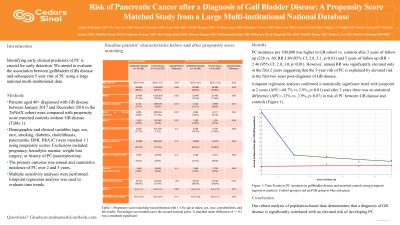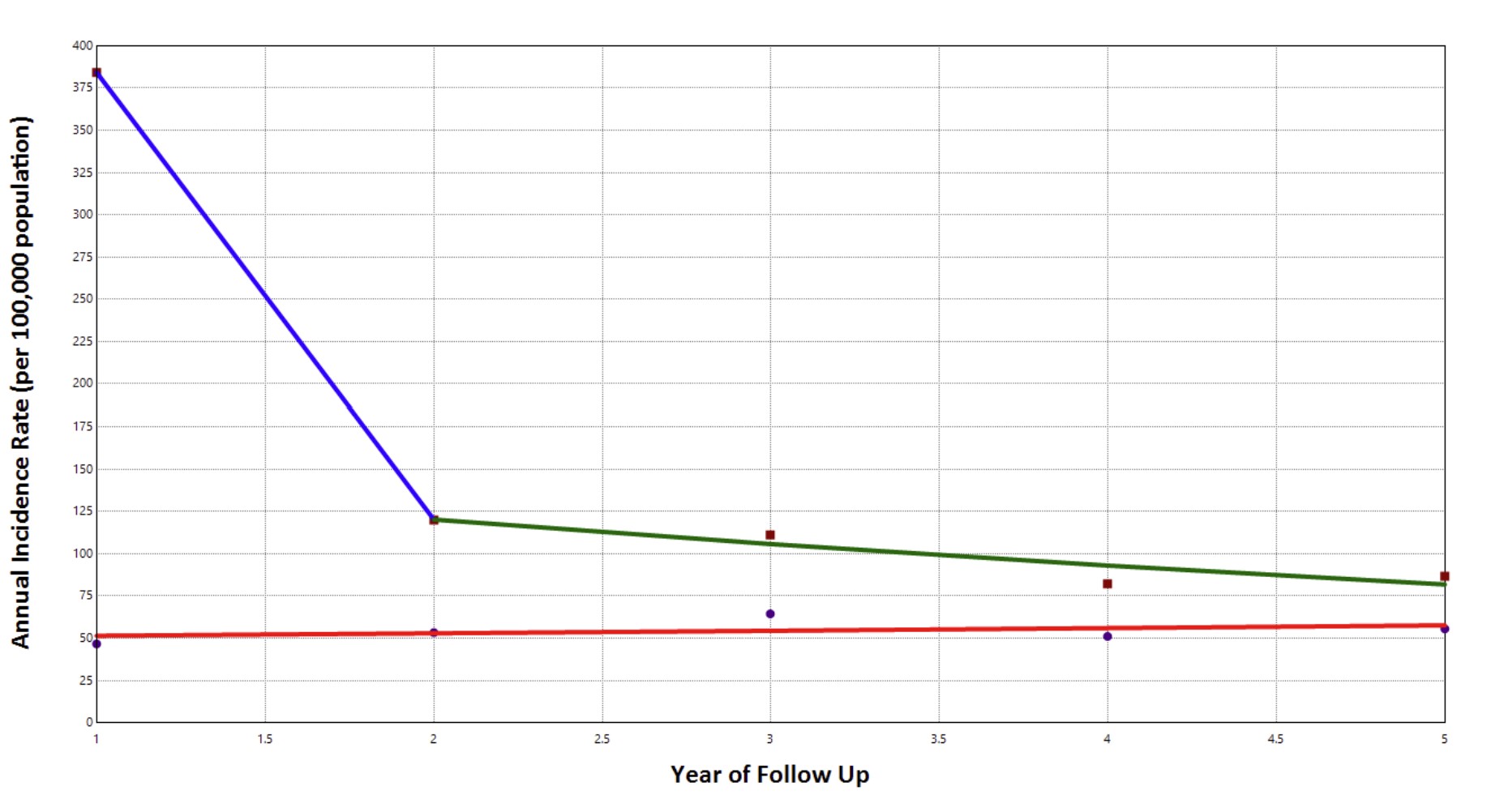Sunday Poster Session
Category: Biliary/Pancreas
P0016 - Risk of Pancreatic Cancer After a Diagnosis of Gallbladder Disease: A Propensity Score Matched Study From a Large Multi-institutional National Database
Sunday, October 27, 2024
3:30 PM - 7:00 PM ET
Location: Exhibit Hall E

- GM
Ghada Mohamed, MD
Cedars-Sinai Medical Center
Burlinton, MA
Presenting Author(s)
Ghada Mohamed, MD1, Yee Hui Yeo, MD2, Gerardo Perrotta, MD2, Malak Munir, MD2, Amar K. Rai, MBBS3, Kenneth Park, MD2, Quin Liu, MD2, Rabindra Watson, MD2, Stephen Pandol, MD2, Ju Dong Yang, MD2, Brent Larson, DO2, Nicholas Nissen, MD2, Kambiz Kosari, MD2, Cristina Ferrone, MD2, Mohammad Karim, PhD, PharmD4, Hye Chung Kum, PhD5, Kevin Ma, 6, Todd Baron, MD7, Simon Lo, MD2, Srinivas Gaddam, MD, MPH2
1Cedars-Sinai Medical Center, Burlinton, MA; 2Cedars-Sinai Medical Center, Los Angeles, CA; 3Imperial College London, Slough, England, United Kingdom; 4University of Nevada, Las Vegas, NV; 5Texas A&M, College Station, TX; 6Brigham and Women's Hospital, Harvard Medical School, Boston, MA; 7University of North Carolina at Chapel Hill School of Medicine, Chapel Hill, NC
Introduction: Identifying early clinical predictors of PC is crucial for early detection. We aimed to evaluate the association between gallbladder (GB) disease and subsequent 5-year risk of PC using a large national multi-institutional data.
Methods: Patients aged 40+ diagnosed with GB disease between January 2017 and December 2018 in the TriNetX cohort were compared with propensity score matched controls without GB disease. Demographic and clinical variables (age, sex, race, smoking, diabetes, cholelithiasis, pancreatitis, BMI, HbA1C) were matched 1:1 using propensity scores. Exclusions included pregnancy, hemolytic anemia, weight loss surgery, or history of PC/pancreatectomy. The primary outcome was annual and cumulative incidence of PC over 2 and 5 years. Multiple sensitivity analyses were performed. Joinpoint regression analysis was used to evaluate time trends.
Results: 45,388 cases and 6,182,536 controls met the inclusion criteria. Propensity score matching resulted in two cohorts of 45,388 patients each, with a standardized mean difference (SMD) of < 0.1 for each covariate. PC incidence per 100,000 was higher in GB cohort vs. controls after 2 years of follow up (228 vs. 60, RR 3.80 (95% CI: 2.8, 5.1, p< 0.01) and 5 years of follow up (RR = 2.46 (95% CI: 2.0, 3.0, p< 0.01). However, annual RR was significantly elevated only in the first 2 years suggesting that the 5-year risk of PC is explained by elevated risk in the first two years post-diagnosis of GB disease (Table 1). Joinpoint regression analysis confirmed a statistically significant trend with joinpoint at 2 years (APC=-68.7% vs 2.9%, p< 0.01) and after 2 years there was no statistical difference (APC=-12% vs. 2.9%, p=0.07) in risk of PC between GB disease and controls (Figure 1). Multiple sensitivity analyses, performed by altering the subgroups and varying the definitions of GB disease, confirmed the robustness of our results.
Discussion: Our robust analysis of population-based data demonstrates that a diagnosis of GB disease is significantly correlated with an elevated risk of developing PC. Current cross-sectional imaging can miss small pancreatic head tumors, which may cause bile duct effects that present as a dilated GB. This can lead to a misdiagnosis of GB disease or an accurate diagnosis of co-presentation of GB disease, while the diagnosis of PC may be missed. This explains the elevated risk of PC for 2 years, necessitating a careful inspection of the pancreas to enable early diagnosis.

Note: The table for this abstract can be viewed in the ePoster Gallery section of the ACG 2024 ePoster Site or in The American Journal of Gastroenterology's abstract supplement issue, both of which will be available starting October 27, 2024.
Disclosures:
Ghada Mohamed, MD1, Yee Hui Yeo, MD2, Gerardo Perrotta, MD2, Malak Munir, MD2, Amar K. Rai, MBBS3, Kenneth Park, MD2, Quin Liu, MD2, Rabindra Watson, MD2, Stephen Pandol, MD2, Ju Dong Yang, MD2, Brent Larson, DO2, Nicholas Nissen, MD2, Kambiz Kosari, MD2, Cristina Ferrone, MD2, Mohammad Karim, PhD, PharmD4, Hye Chung Kum, PhD5, Kevin Ma, 6, Todd Baron, MD7, Simon Lo, MD2, Srinivas Gaddam, MD, MPH2. P0016 - Risk of Pancreatic Cancer After a Diagnosis of Gallbladder Disease: A Propensity Score Matched Study From a Large Multi-institutional National Database, ACG 2024 Annual Scientific Meeting Abstracts. Philadelphia, PA: American College of Gastroenterology.
1Cedars-Sinai Medical Center, Burlinton, MA; 2Cedars-Sinai Medical Center, Los Angeles, CA; 3Imperial College London, Slough, England, United Kingdom; 4University of Nevada, Las Vegas, NV; 5Texas A&M, College Station, TX; 6Brigham and Women's Hospital, Harvard Medical School, Boston, MA; 7University of North Carolina at Chapel Hill School of Medicine, Chapel Hill, NC
Introduction: Identifying early clinical predictors of PC is crucial for early detection. We aimed to evaluate the association between gallbladder (GB) disease and subsequent 5-year risk of PC using a large national multi-institutional data.
Methods: Patients aged 40+ diagnosed with GB disease between January 2017 and December 2018 in the TriNetX cohort were compared with propensity score matched controls without GB disease. Demographic and clinical variables (age, sex, race, smoking, diabetes, cholelithiasis, pancreatitis, BMI, HbA1C) were matched 1:1 using propensity scores. Exclusions included pregnancy, hemolytic anemia, weight loss surgery, or history of PC/pancreatectomy. The primary outcome was annual and cumulative incidence of PC over 2 and 5 years. Multiple sensitivity analyses were performed. Joinpoint regression analysis was used to evaluate time trends.
Results: 45,388 cases and 6,182,536 controls met the inclusion criteria. Propensity score matching resulted in two cohorts of 45,388 patients each, with a standardized mean difference (SMD) of < 0.1 for each covariate. PC incidence per 100,000 was higher in GB cohort vs. controls after 2 years of follow up (228 vs. 60, RR 3.80 (95% CI: 2.8, 5.1, p< 0.01) and 5 years of follow up (RR = 2.46 (95% CI: 2.0, 3.0, p< 0.01). However, annual RR was significantly elevated only in the first 2 years suggesting that the 5-year risk of PC is explained by elevated risk in the first two years post-diagnosis of GB disease (Table 1). Joinpoint regression analysis confirmed a statistically significant trend with joinpoint at 2 years (APC=-68.7% vs 2.9%, p< 0.01) and after 2 years there was no statistical difference (APC=-12% vs. 2.9%, p=0.07) in risk of PC between GB disease and controls (Figure 1). Multiple sensitivity analyses, performed by altering the subgroups and varying the definitions of GB disease, confirmed the robustness of our results.
Discussion: Our robust analysis of population-based data demonstrates that a diagnosis of GB disease is significantly correlated with an elevated risk of developing PC. Current cross-sectional imaging can miss small pancreatic head tumors, which may cause bile duct effects that present as a dilated GB. This can lead to a misdiagnosis of GB disease or an accurate diagnosis of co-presentation of GB disease, while the diagnosis of PC may be missed. This explains the elevated risk of PC for 2 years, necessitating a careful inspection of the pancreas to enable early diagnosis.

Figure: Figure 1: Time Trends in PC incidence in gallbladder disease and matched controls using joinpoint regression analysis.
Top line: GB Disease, Bottom line: Controls.
Top line: GB Disease, Bottom line: Controls.
Note: The table for this abstract can be viewed in the ePoster Gallery section of the ACG 2024 ePoster Site or in The American Journal of Gastroenterology's abstract supplement issue, both of which will be available starting October 27, 2024.
Disclosures:
Ghada Mohamed indicated no relevant financial relationships.
Yee Hui Yeo indicated no relevant financial relationships.
Gerardo Perrotta indicated no relevant financial relationships.
Malak Munir indicated no relevant financial relationships.
Amar Rai indicated no relevant financial relationships.
Kenneth Park indicated no relevant financial relationships.
Quin Liu indicated no relevant financial relationships.
Rabindra Watson: Allurion – Grant/Research Support. Ambu Inc – Consultant. Apollo Endosurgery – Consultant, Speakers Bureau. Boston scientific – Consultant, Speakers Bureau. Intuitive surgical – Advisory Committee/Board Member.
Stephen Pandol indicated no relevant financial relationships.
Ju Dong Yang indicated no relevant financial relationships.
Brent Larson indicated no relevant financial relationships.
Nicholas Nissen indicated no relevant financial relationships.
Kambiz Kosari indicated no relevant financial relationships.
Cristina Ferrone indicated no relevant financial relationships.
Mohammad Karim indicated no relevant financial relationships.
Hye Chung Kum indicated no relevant financial relationships.
Kevin Ma indicated no relevant financial relationships.
Todd Baron: Ambu – Consultant, Speakers Bureau. Boston Scientific – Consultant, Speakers Bureau. Cook Endoscopy – Consultant, Speakers Bureau. Medtronic – Consultant, Speakers Bureau. Olympus America – Consultant, Speakers Bureau. W.L. Gore – Consultant, Speakers Bureau.
Simon Lo: Boston Scientific – Teaching, Speakers Bureau. Fujifilm – Consultant. Olympus America – Consultant.
Srinivas Gaddam: Boston Scientific – Advisory Committee/Board Member.
Ghada Mohamed, MD1, Yee Hui Yeo, MD2, Gerardo Perrotta, MD2, Malak Munir, MD2, Amar K. Rai, MBBS3, Kenneth Park, MD2, Quin Liu, MD2, Rabindra Watson, MD2, Stephen Pandol, MD2, Ju Dong Yang, MD2, Brent Larson, DO2, Nicholas Nissen, MD2, Kambiz Kosari, MD2, Cristina Ferrone, MD2, Mohammad Karim, PhD, PharmD4, Hye Chung Kum, PhD5, Kevin Ma, 6, Todd Baron, MD7, Simon Lo, MD2, Srinivas Gaddam, MD, MPH2. P0016 - Risk of Pancreatic Cancer After a Diagnosis of Gallbladder Disease: A Propensity Score Matched Study From a Large Multi-institutional National Database, ACG 2024 Annual Scientific Meeting Abstracts. Philadelphia, PA: American College of Gastroenterology.

